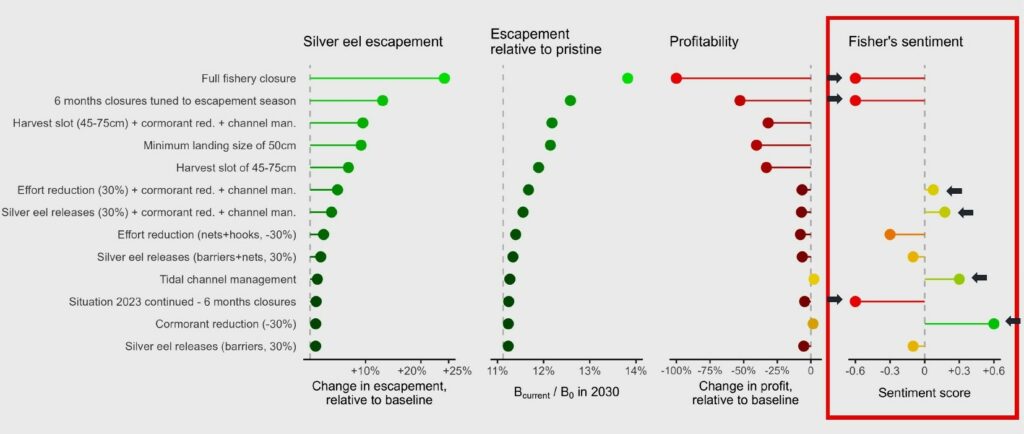The General Fisheries Commission for the Mediterranean publishes its report on eels: there is a sharp divergence between the opinions of scientists and fishermen on the measures to be taken, and considerable effort is needed to improve assessment.
On 4 and 5 June 2024, eel experts met at the FAO headquarters in Rome to finalise their recommendations on the management plan for eel in the Mediterranean.
The aim of the meeting was to define a roadmap for the long-term management of this resource by controlling fishing mortality while maintaining a certain level of income for professional eel fishermen. Assess the impact of different management scenarios combining various measures to reduce fishing mortality and restore habitats, ecological continuity and predator control.
The interest of this meeting was in the presentation of the results from the first questionnaires and surveys carried out among professional fishermen on the socio-economics of their activities, their ecological knowledge on a local scale and their opinions on management measures.
A series of workshops were organised to better understand the environmental, social and economic context of the exploitation of this resource in the Mediterranean.
With regard to the potential habitat of eels in the Mediterranean:
The total surface area potentially usable by the species is estimated at 1,159,944 hectares, two-thirds of which (769,699 hectares) are lagoon ecosystems. 25% are made up of rivers and estuaries, and just under 10% by lakes.
– Many of these ecosystems are eutrophied or hyper-eutrophied. With the exception of the lagoons on the French side, many of the lagoon ecosystems are suffering from hydrological disequilibrium resulting in high fish mortality, drought (74%) and increased salinity (36%).
– Ecological continuity is severely hampered between the various environments: sea, lagoons, estuaries, rivers and lakes. 25% of the lagoon surface area can be naturally colonised, allowing silver eels to escape without human intervention.
– Of the 862,695 hectares inventoried and analysed, i.e. 74% of the potential surface area available for eels, only 36% (311,885 hectares) can be naturally colonised by this species.
– In 45% of estuaries and deltas, glass eel recruitment occurs at least in the lower reaches of rivers, but less than a third of the wetted surface area of rivers can be used by eels.
– The lakes are poorly connected to the hydrological network and therefore cannot be colonised naturally by the species.
In conclusion, the General Fisheries Commission for the Mediterranean considers that:
– The habitat of this species is in a critical state in the Mediterranean basin;
– There is an urgent need to restore these ecosystems and reduce mortality unrelated to fishing.
With regard to fishermen’s knowledge about the ecology of the environments they exploit.
791 interviews were carried out, including 501 with fishermen exploiting lagoon ecosystems.
It emerged that:
– Eel fishing is generally a family activity: knowledge and know-how are transmitted between generations;
– This activity is more a passion than an employment for many of them, but the difficulty of the work, the excessive administrative constraints and the conflicts with poachers greatly reduce their motivation to continue in this profession.
– For many of them, fishing is their main source of income, but it is combined with a secondary activity because of the limited revenue available and the increasingly limited possibilities for exploitation.
– Their knowledge of the environment provides them with relevant information and opinions on how to mitigate the effects of human activity and solve a number of problems. They are aware of the degradation of the resource and have warned the authorities about it. They are therefore keen to collaborate actively in the management of this species and its environment.
– They emphasise and insist on the fact that it is not enough to put in place measures to regulate fishing if we want to restore the species.
AFPMAR comment: The findings of the Habitat workshop justify this last sentence. It seems impossible to restore the resource to its pristine biomass (B0) without intervening in other anthropogenic factors, when only a third of the habitats are naturally available for the species.
As for the multi-objective workshop.
The aim is to develop a scenario for increasing silver eel escapement in the short term by 2030.
Various measures were evaluated and the results are summarised in the figure below.

Fishermen’s feelings on these measures are very clear: NO to more restrictive measures on fishing; YES to measures for reducing cormorant populations, improving ecological continuity or combined measures: releasing silver eels; reducing cormorant populations and improving ecological continuity.
Comments AFPMAR: If measures are only taken on fishing, this means that only a third of the naturally available surface area is being considered and therefore achieving 40% of the pristine biomass (target set by regulation 1100/2007) cannot be seriously considered. Furthermore, a restriction on silver eel escapement at basin level, and a fortiori at local level, cannot have an immediate effect on glass eel recruitment, which is mainly directed towards the central Atlantic part of the distribution area. Finally, for the other measures, as the GFCM points out (page 66 of the GFCM expert group report), the lack of data makes it difficult to estimate the benefits for the species resulting from these measures.